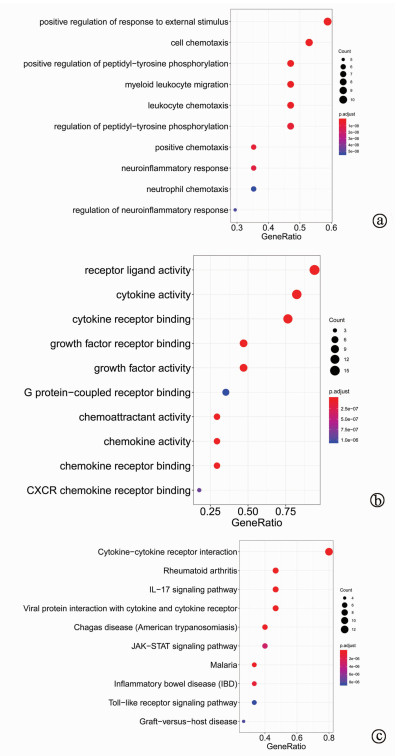| [1] |
LEE HW, SUH KS. Liver transplantation for advanced hepatocellular carcinoma[J]. Clin Mol Hepatol, 2016, 22(3): 309-318. DOI: 10.3350/cmh.2016.0042 |
| [2] |
LIU H, LO CM, YEUNG O, et al. NLRP3 inflammasome induced liver graft injury through activation of telomere-independent RAP1/KC axis[J]. J Pathol, 2017, 242(3): 284-296. DOI: 10.1002/path.4901 |
| [3] |
ZHAI Y, BUSUTTIL RW, KUPIEC-WEGLINSKI JW. Liver ischemia and reperfusion injury: New insights into mechanisms of innate-adaptive immune-mediated tissue inflammation[J]. Am J Transplant, 2011, 11(8): 1563-1569. DOI: 10.1111/j.1600-6143.2011.03579.x |
| [4] |
HONG BJ, LIU H, WANG ZH, et al. Inflammasome activation involved in early inflammation reaction after liver transplantation[J]. Immunol Lett, 2017, 190: 265-271. DOI: 10.1016/j.imlet.2017.08.020 |
| [5] |
CHALIN A, LEFEVRE B, DEVISME C, et al. Serum CXCL10, CXCL11, CXCL12, and CXCL14 chemokine patterns in patients with acute liver injury[J]. Cytokine, 2018, 111: 500-504. DOI: 10.1016/j.cyto.2018.05.029 |
| [6] |
SAHIN H, BORKHAM-KAMPHORST E, DO O NT, et al. Proapoptotic effects of the chemokine, CXCL 10 are mediated by the noncognate receptor TLR4 in hepatocytes[J]. Hepatology, 2013, 57(2): 797-805. DOI: 10.1002/hep.26069 |
| [7] |
JIMÉNEZ-CASTRO MB, CORNIDE-PETRONIO ME, GRACIA-SANCHO J, et al. Inflammasome-mediated inflammation in liver ischemia-reperfusion injury[J]. Cells, 2019, 8(10): 1131. DOI: 10.3390/cells8101131 |
| [8] |
BARBIER L, FERHAT M, SALAMÉ E, et al. Interleukin-1 family cytokines: Keystones in liver inflammatory diseases[J]. Front Immunol, 2019, 10: 2014. DOI: 10.3389/fimmu.2019.02014 |
| [9] |
LEA JD, CLARKE JI, MCGUIRE N, et al. Redox-dependent hmgb1 isoforms as pivotal co-ordinators of drug-induced liver injury: Mechanistic biomarkers and therapeutic targets[J]. Antioxid Redox Signal, 2016, 24(12): 652-665. DOI: 10.1089/ars.2015.6406 |
| [10] |
FAN X, DU J, WANG MH, et al. Irisin contributes to the hepatoprotection of dexmedetomidine during intestinal ischemia/reperfusion[J]. Oxid Med Cell Longev, 2019, 2019: 7857082. http://www.ncbi.nlm.nih.gov/pubmed/31191804 |
| [11] |
LADUE JS, WROBLEWSKI F. Serum glutamic pyruvic transaminase SGP-T in hepatic disease: A preliminary report[J]. Ann Intern Med, 1956, 45(5): 801-811. DOI: 10.7326/0003-4819-45-5-801 |
| [12] |
KALTENBACH MG, HARHAY MO, ABT PL, et al. Trends in deceased donor liver enzymes prior to transplant: The impact on graft selection and outcomes[J]. Am J Transplant, 2020, 20(1): 213-219. DOI: 10.1111/ajt.15573 |
| [13] |
MANGUS RS, FRIDELL JA, KUBAL CA, et al. Elevated alanine aminotransferase (ALT) in the deceased donor: Impact on early post-transplant liver allograft function[J]. Liver Int, 2015, 35(2): 524-531. DOI: 10.1111/liv.12508 |
| [14] |
D'HAESE JG, DEMIR IE, FRIESS H, et al. Fractalkine/CX3CR1: Why a single chemokine-receptor duo bears a major and unique therapeutic potential[J]. Expert Opin Ther Targets, 2010, 14(2): 207-219. DOI: 10.1517/14728220903540265 |
| [15] |
SUTTI S, HEYMANN F, BRUZZí S, et al. CX3CR1 modulates the anti-inflammatory activity of hepatic dendritic cells in response to acute liver injury[J]. Clin Sci (Lond), 2017, 131(17): 2289-2301. DOI: 10.1042/CS20171025 |
| [16] |
EFSEN E, GRAPPONE C, DEFRANCO RM, et al. Up-regulated expression of fractalkine and its receptor CX3CR1 during liver injury in humans[J]. J Hepatol, 2002, 37(1): 39-47. DOI: 10.1016/S0168-8278(02)00065-X |
| [17] |
OBARA H, NAGASAKI K, HSIEH CL, et al. IFN-gamma, produced by NK cells that infiltrate liver allografts early after transplantation, links the innate and adaptive immune responses[J]. Am J Transplant, 2005, 5(9): 2094-2103. DOI: 10.1111/j.1600-6143.2005.00995.x |
| [18] |
SAFIRI S, ASHRAFI-ASGARABAD A. High serum soluble CD40L levels previously to liver transplantation in patients with hepatocellular carcinoma are associated with mortality at one year: Methodological issues[J]. J Crit Care, 2018, 43: 370. DOI: 10.1016/j.jcrc.2017.10.010 |
| [19] |
ERCIN CN, DOGRU T, TAPAN S, et al. Levels of soluble CD40 ligand and P-Selectin in nonalcoholic fatty liver disease[J]. Dig Dis Sci, 2010, 55(4): 1128-1134. DOI: 10.1007/s10620-009-0817-1 |
| [20] |
BERRES M, TRAUTWEIN C, SCHMEDING M, et al. Serum chemokine CXC ligand 10 (CXCL10) predicts fibrosis progression after liver transplantation for hepatitis C infection[J]. Hepatology, 2011, 53(2): 596-603. DOI: 10.1002/hep.24098 |
| [21] |
|
| [22] |
BERKHOUT L, BARIKBIN R, SCHILLER B, et al. Deletion of tumour necrosis factor α receptor 1 elicits an increased TH17 immune response in the chronically inflamed liver[J]. Sci Rep, 2019, 9(1): 4232. DOI: 10.1038/s41598-019-40324-z |
| [23] |
SUTTI S, BRUZZí S, HEYMANN F, et al. CX3CR1 mediates the development of monocyte-derived dendritic cells during hepatic inflammation[J]. Cells, 2019, 8(9): 1099. DOI: 10.3390/cells8091099 |
| [24] |
DEAR J, CLARKE J, FRANCIS B, et al. Risk stratification after paracetamol overdose using mechanistic biomarkers: Results from two prospective cohort studies[J]. Lancet Gastroenterol Hepatol, 2018, 3(2): 104-113. DOI: 10.1016/S2468-1253(17)30266-2 |








 DownLoad:
DownLoad:
